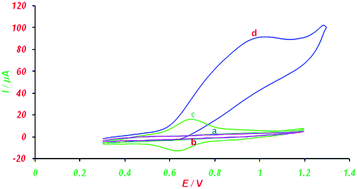Electrocatalytic oxidation and determination of ceftriaxone sodiumantibiotic in pharmaceutical samples on a copper hexacyanoferrate nanostructure
Abstract
A copper hexacyanoferrate

* Corresponding authors
a
Department of Analytical Chemistry, Faculty of Chemistry, University of Tabriz, Tabriz, Iran
E-mail:
sr.majidi@gmail.com
Fax: + 98 411 3340191
Tel: + 98 411 3393111
b Quality Control Department, Daana Pharmaceutical Co., Tabriz, Iran
A copper hexacyanoferrate

 Please wait while we load your content...
Something went wrong. Try again?
Please wait while we load your content...
Something went wrong. Try again?
M. R. Majidi, K. Asadpour-Zeynali and B. Hafezi, Anal. Methods, 2011, 3, 646 DOI: 10.1039/C0AY00582G
To request permission to reproduce material from this article, please go to the Copyright Clearance Center request page.
If you are an author contributing to an RSC publication, you do not need to request permission provided correct acknowledgement is given.
If you are the author of this article, you do not need to request permission to reproduce figures and diagrams provided correct acknowledgement is given. If you want to reproduce the whole article in a third-party publication (excluding your thesis/dissertation for which permission is not required) please go to the Copyright Clearance Center request page.
Read more about how to correctly acknowledge RSC content.
 Fetching data from CrossRef.
Fetching data from CrossRef.
This may take some time to load.
Loading related content
